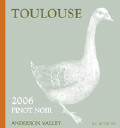PinotFile: 6.60 June 9, 2008
|
Anderson Valley: Hot & Cold But CoolIn the middle of May I found myself cruising north along Interstate Highway 101 heading for the 11th Annual Anderson Valley Pinot Noir Festival sponsored by the Anderson Valley Winegrower’s Association. As I turned west on Highway 128 for the winding and scenic 40 minute drive to the bucolic Anderson Valley, I noted a significant rise in temperature. By the time I had reached Boonville, it was nearly 100°F! The heat spell, which was to continue all weekend, was a shock to the locals. Anderson Valley is classified as a Region I viticulture area in the lower or more northerly part of the valley, and Region II in the upper valley around Boonville according to the heat summation classification developed by two University of California Davis professors, Albert Winkler and Maynard Amerine. The classification is based on heat summation, that is, the number of units of heat or “degree-days” available to ripen grapes. The heat units are determined by the length in days and the average daily temperature. Region I has less than 2.500 heat units, and Region II, 2,5001 to 3,500 heat units. Other wine growing areas designated as Region I are Carneros, Santa Cruz Mountains, Santa Maria Valley, Burgundy and Champagne. Edna Valley and the Russian River Valley are Region II areas. Cool-climate varieties such as Pinot Noir are right at home in Regions I and II.
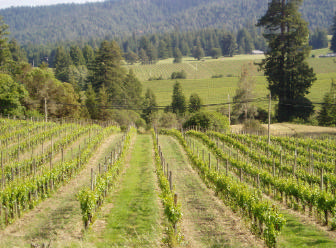 The heat wave in May was inopportune for it had been preceded in April by two weeks of frosts. The April cold snap affected most parts of Northern California, but the Anderson Valley was hit especially hard. Many veteran winegrowers said that it was the worst series of frosts since the early 1970s. The photo on page 2 from Inman Family Olivet Grange Vineyard in the Russian River Valley illustrates the damage that frost can do to young shoots (photo on left is normal bud growth at Goldeneye Confluence Vineyard, photo on right is damaged shoot). Early budding varieties, such as Pinot Noir, are especially vulnerable to frost damage. Fred Buonanno, owner of Philo Ridge Vineyards in the Anderson Valley, said that although his vineyard is located at 1,200 feet, he lost 70 percent of his Pinot Noir and 90 percent of his Pinot Gris. In talking with growers in the Anderson Valley during my trip, they spoke of some vineyards being spared and others suffering 80 percent or more loss of bud growth. The searing heat wave that followed in May in Northern California created a jolt in weather conditions that further stressed the vines. In general, vines prefer gradual changes in temperature. Both frost and extreme heat kill the flowers on the young shoots that must be pollinated to develop into grapes. A grapevine has three growth points or buds (primary, secondary, tertiary). The primary buds develop first and produce the largest and most desirable crop. If damaged, the secondary or tertiary buds may develop into grapes, but the net result will be that grape quantity, but not quality, will be reduced. There are a few active methods that growers use to deal with frost. Fans or helicopters can mix the warm air above with the layer of cold air close to the ground helping to prevent frost from settling on vines. Overhead sprinklers or microsprayers can provide a protective coating of water that insulates vines from damage (the action of the liquid turning to a solid actually puts off heat in the process, keeping the tender shoots safe). Heaters accomplish the same result.
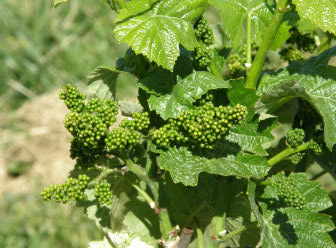
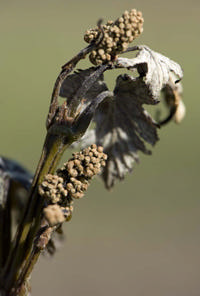 The Anderson Valley received appellation status in 1983 and among eleven grape-growing appellations in Mendocino County, is uniquely suited to growing Pinot Noir. The latest data from Glenn McGourty, a winegrowing and plant science advisor for Mendocino County, shows that there are 1,128 acres of Pinot Noir in Anderson Valley, 383 acres in Potter Valley, 154 acres in Redwood Valley, 69 acres in Ukiah Valley, and 49 acres in Yorkville Highlands. Total vineyard acreage for all varieties in Anderson Valley is 2,200 acres.
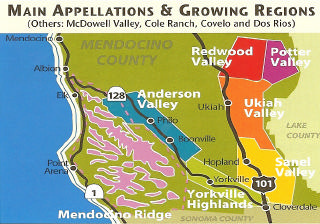
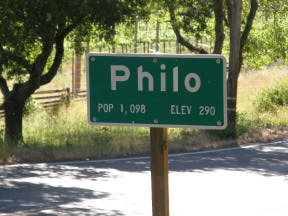 The Anderson Valley is a relatively isolated, small and narrow valley, ½ to 1½ miles wide, and 16 miles wide. It is bordered on three sides by 2,000 to 3,000 foot mountains and is only 18 miles from the Pacific Ocean at its northern tip or “deep end.” The valley opens on its northern end to the Pacific coast via the Navarro River Canyon and this unique topography allows fog to roll into the valley in the early morning and gentle, cooling breezes to enter in the afternoon. A gradient is thereby created, with the northern ocean end, referred to by locals as “down-valley,” receiving more rain and fog and thus cooler, and the southern inland portion, or “upper-valley,” being typically 8-10°F warmer. The valley’s vineyards and wineries are clustered along the fringes of Highway 128, which bisects the valley, with a majority of them located down-valley. Along Highway 128, the vineyards begin at the town of Boonville, continue north through Philo, and end in the tiniest hamlet of the three, Navarro, population 67. As it continues north, Highway 128 winds through redwood forests, eventually reaching the town of Mendocino and the Pacific Ocean. The latest map of Anderson Valley published by the Anderson Valley Winegrowers Association (www.avwines.com) is on page 4. To visit Anderson Valley is to leave the world of roadside McDonalds, convenience stores, and Starbucks behind and encounter a pastoral countryside teaming with moss-covered majestic oaks, manzanitas, ramshackle old barns, and grassy meadows with calmly grazing sheep and cows. Boonville is the center of “activity” in the valley. About 3,000 people are scattered throughout the valley, a fourth of them calling Boonville home. Boonville is known as Boont in the local language of Anderson Valley called boontling. In the 1800s, this original code-like dialect became the spoken word for many of the valley residents. The exact origins are unclear, but many attribute the beginnings to the mothers and children who worked in the hop fields prevalent in the valley at the time. The isolation of the valley and the distrust of city people (“brightlighters”) fostered the language. Terms included “baul seep” - lovers of wine, “baul hornin” - good drinking, “Frati” - wine (Mr Frati was a local vineyard owner), “Frati shams” - wine grapes, “breggo” - sheep, and “backdated chuck” - someone who is behind the times. Many of the words had their origins in the languages of the Scottish, Irish, Spanish, and Pomo Indians who settled in the valley. Today, fragments of boontling remain as slang terms and the locals still have a cautious distrust of city people. If you visit, avoid incurring the wrath of locals by appearing to be a raging “brightlighter.” Leave your designer jeans, Louis Vitton bags, and Polo shirts at home. The Pomo tribe were the original Native American inhabitants of Anderson Valley. Among the first white settlers were the Anderson family in 1851. Walter Anderson planted the first apple trees in the valley. Soon, other crops such as pears and hops were ubiquitous, and a thriving timber industry developed. The 1960s brought an influx of hippies drawn to the beauty and isolation of the valley. During the 1970s and 1980s, urban refugees bought ranches and replaced apple and pear orchards with vineyards. The latest newcomers to the valley are Mexican laborers valued for their work in the vineyards. Olives are the newest crop and several olive oil producers have appeared including the well-regarded Stella Cadente. Anderson Valley’s largest crop in revenue (including grapes) is marijuana. If you visit, and are searching for vineyards off the main highway, proceed with extreme caution as you may receive a volley of buckshot as a reward for your inquisitiveness. In the late 1800s, small vineyards began to be planted in the valley. After 1900, Italian settlers came to
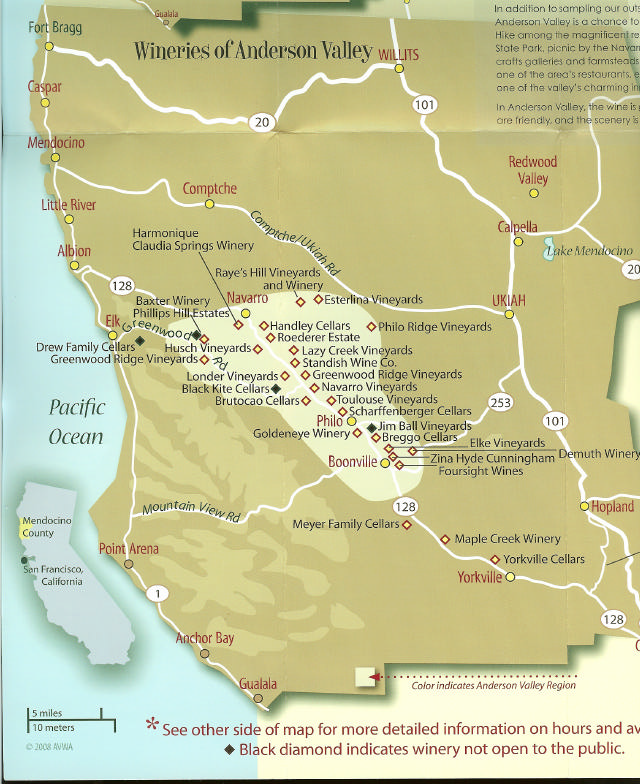 Mendocino from San Francisco and had success growing grapes above the valley floor along the Greenwood Ridge. Today, some of these original Zinfandel vineyards still survive. After Prohibition, attempts to grow grapes in the valley by Asti, Goodhue, and Pinoli were largely unsuccessful because of poor choice of varieties and problems with ripeness and frosts. The modern history of winegrowing in the Anderson Valley is linked to four winery names: Edmeades, Husch, Lazy Creek, and Navarro. In 1963, Dr. Donald Edmeades, a Pasadena, California cardiologist, purchased land north of Philo and planted 24 acres of grapes. The locals were quite skeptical, and Edmeades, in good humor, put up a sign on Highway 128 that read “Edmeades’ Folly.” He had, in fact, carefully researched the potential for premium grape growing in the valley beforehand. Edmeades had success growing Chardonnay and Gewürztraminer, but unfortunately, he passed away from cancer just after his winery was built in 1972. His son Deron took over and made the first vintage. Edmeades (now part of Kendall-Jackson Estates and closed to the public) has achieved notoriety with Zinfandel grown in Mendocino County. Edmeades was never a major player in the Pinot Noir game. The first Pinot Noir planted in the Anderson Valley was by Wilton (Tony) Husch in 1968. Husch had been exposed to Pinot Noir by John Parducci who was a pioneering winegrower in Mendocino County dating back to 1931. A 3-acre parcel of the Husch's property known as the Knoll was chosen. Located on a hillside overlooking the Navarro River, the Knoll vineyard was planted to a Wente field selection of Pinot Noir. The first harvest was in 1971. Long-time vineyard manager, Al White, arrived in 1973, two years after Husch Vineyards became a bonded winery in Anderson Valley. As White recounts his first harvest at Husch in 1974, one is struck by the archaic vineyard management of the time. The vines were planted with 8 ft by 12 ft spacing with overhead irrigation. Trellising was minimal and no leaf pulling was done. Rain at harvest was a problem and with it came mold which was a significant nuisance. The grapes were picked into apple boxes at a very casual pace over several days by a hippie crew. The Knoll Vineyard is still producing Pinot Noir, but has been transformed by more modern viticulture practices. Husch Vineyards was sold to the Oswald family in 1979 and is currently under new ownership (see page 27).
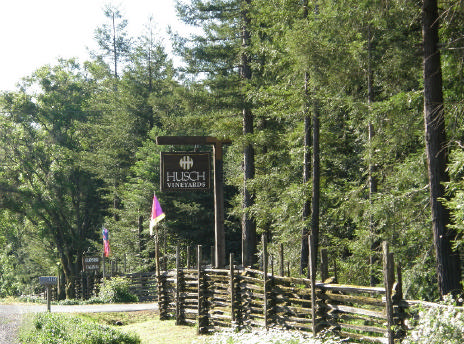 The Greenwood Ridge Vineyard was planted by Tony Husch in 1972 in Mendocino Ridge, an area originally settled by Italian immigrants. Allen Green acquired the vineyard in 1973 and bonded his Greenwood Ridge Winery, located on Highway 128, in 1980. Greenwood Ridge has been the site of the California Wine Tasting Championships ever since 1983.
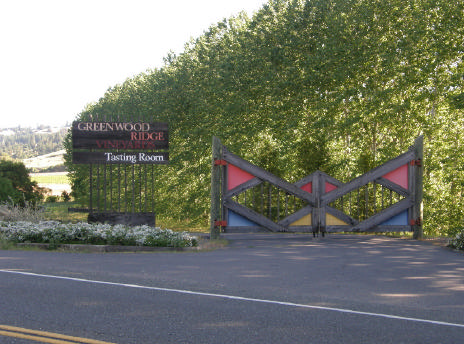 Johann Kobler, a San Francisco restaurateur, and his wife Theresia, purchased the 20-acre Lazy Creek Vineyards in 1969 from the Pinoli family. The Pinolis has farmed the land in Philo since the early 1900s. Pinoli was the first bonded winery in the valley (1911). The Pinolis showed that grapes could ripen here, but they had much more success with their fruit orchards than the vineyards. Kobler was able to revitalize the vineyards, built a small winery (1973), and subsequently became quite successful with both Pinot Noir and Gewürztraminer. Lazy Creek was purchased by Josh and Mary Beth Chandler in 1999, and they have carried on the tradition respectably.
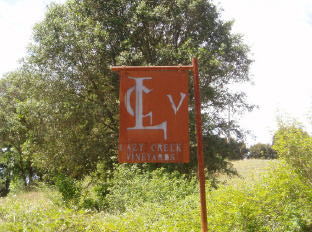 Ted Bennett was a successful businessman when he and his wife, Deborah Cahn, left San Francisco in 1973 and purchased a 900-acre sheep ranch along Highway 128 between Philo and Navarro. They were Alsatian grape aficionados and planted only white varietals when they began in 1974. Pinot Noir came later, and today they have 31 acres of estate Pinot Noir and source additional quantities from other Anderson Valley vineyards. It was largely their marketing sense that put Anderson Valley in the minds of wine enthusiasts and brought notoriety to the wines of this region. They built an attractive tasting room and sent out a very informative newsletter that led to considerable consumer-direct sales and buyer loyalty. Today, their lineup of quality wines is impressive including Gewürztraminer, Riesling, Sauvignon Blanc, Pinot Gris, Muscat, Zinfandel, Syrah, and Pinot Noir (three bottlings including Anderson Valley, Mèthode a l’Ancienne, and Deep End Blend).
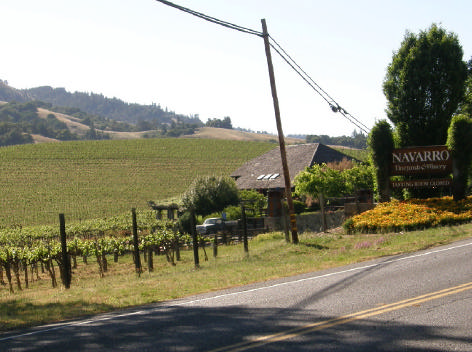 Today, there are 27 wineries and more than 60 vineyards in the Anderson Valley. Some of the vineyard names have become household words to pinophiles: Cerise, Demuth, Donnelly Creek, Ferrington, Hacienda Secoya, Hein Family, Klindt, Morning Dew Ranch, Savoy, Toulouse, and Wiley. At least 28 major California Pinot Noir producers access grapes from Anderson Valley (Anthill Farms, Arista Winery, Adrian Fog, Barnett, Benovia, Brogan Cellars, Cakebread Cellars, Copain Wines, Couloir Wines, Dain Wines, Ferrari-Carano Vineyards and Winery, Fulcrum Wines, Gryphon Wines, Hartford Family Wines, Harrington, Ici/La-Bas, La Crema Winery, Littorai, MacPhail Family Wines, Madrigal Vineyards, Radio-Coteau, Roessler Cellars, Saintsbury, Skewis, Whitcraft, Whitethorn, Williams- Selyem, and Woodenhead Vintners). Most of the vineyards are less than 10 acres, with three large growers, Roederer Estate, Goldeneye, and Navarro controlling the most total acreage. Pinot Noir acreage has dramatically increased since 1997, and now accounts for more than 50 percent of Anderson Valley’s planted vineyard acreage (see graph displayed at the Anderson Valley Pinot Noir Festival Technical Conference by Glen McGourty showing the increase in Pinot Noir plantings in California and Mendocino, 1997-2005, page 8). Despite the desirability and quality of Pinot Noir grapes from Anderson Valley, the average price per ton still lags other prominent California AVAs. The latest figures: Santa Barbara County - $2,918 per ton, Sonoma County - $2,826 per ton, Napa County - $2,412 per ton, Mendocino County - $2,348 per ton, and Monterey County - $1,806 per ton. However, Pinot Noirs grapes from prestigious Anderson Valley vineyards can command up to $6,000 per ton.
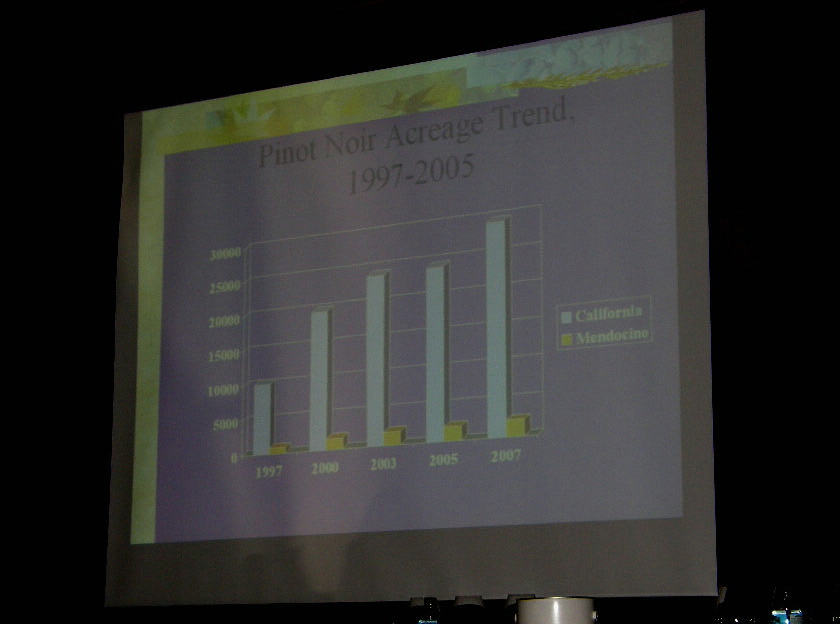
2008 Anderson Valley Pinot Noir Festival
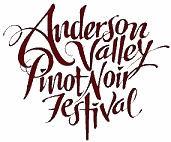
Excerpts from the Technical Conference
John Winthrop Haeger, author North American Pinot Noir and Pacific Pinot Noir If you get the opportunity to hear John Haeger speak about Pinot Noir, jump at the chance. He is a very literate academic who is also quite humorous and happens to know more about the Pinot Noir grape than anyone else on this planet. Although his talk was titled as above, he focused on “Top Ten Reasons to Love (or Hate) Pinot Noir” to make his points.
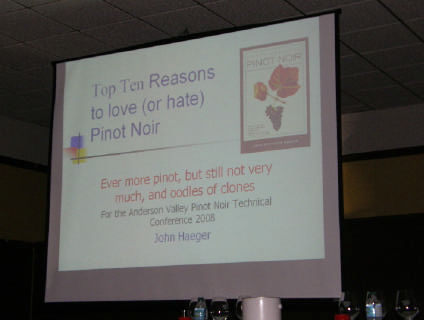 #10 Pinot Noir remains the most lightly planted grape varietal in the world. It is low-yielding, small-berried, thin-skinned and disease-sensitive. #9 If Pinot Noir is mistreated, it will retaliate. #8 Pinot Noir is hard not to love as some of its children are sweet and successful. There are at least 16 offspring varieties: Auxerrois, Melon, Franc noir de la Haute Saone, Aubin nert, Enard, Bechet noir, Roublot, Aligote, Romerentin, Saoy, Knipperie, Gamay noir, Begunoir, Dameron, and Gamay blanc. #7 Pinot Noir smells or tastes like almost everything good and bad. It mimics everything on the aroma wheel. #6 Pinot Noir attracts more “purple prose” than any other variety. #5 Pinot Noir befuddles critics. Nobody knows what is supposed to taste like. #4 Finally more and more is being planted. There has been a doubling of planting in the last 40 years, not in Burgundy’s Cote d’Or , but in Champagne, Languedoc (huge amounts), and Corsica. There are widespread reports that a new Two Buck Chuck Pinot Noir will come from Corsica. Plantings have also increased in Germany and in Switzerland. There has been a doubling of Pinot Noir plantings in Germany in the last 20 years, and close to a doubling in Switzerland. Some of the new plantings is replacing white grape acreage. In the last ten years there has been a marked increase in Pinot Noir acreage in New Zealand as well. #3 There still is not a lot of Pinot Noir: 38,000 acres of Pinot Noir in North America and 160,000 acres worldwide (estimate). This is small in comparison to the worldwide 6,400,000 acres of wine grapes. There are 27,000 acres of Pinot Noir in California and 9,000 acres in Oregon. Pinot Noir makes up 2% of the worldwide wine grape vineyard area and about 1.1% of the worldwide wine production. #2 If you love Pinot, which Pinot? All Pinot Noir came from a common source - one alpha vine - either a domesticated wild vine or a wild vine crossed with a previously domesticated vine or a neutral crossing of two previously domesticated varieties or a lab crossing of two varieties. It first showed up in southeast France but not certain if it was Burgundy. Pinot Gris, Pinot Blanc and Pinot Meunier are color mutations of Pinot Noir, not offspring - all have the same parentage. “Clone speak can make you nuts.” It is a jungle of alphanumeric shorthand. There are more than 800 clones of Pinot Noir in conservatory collections in France. Of those, 43 are “approved.” 31 of the 43 are widely distributed. 21 of the 43 +3 have UCD/FPS numbers. Haeger looked at all of the Pinot Noir vines ordered from California nurseries in 2006-2007. Not all nurseries responded but the following is clear. There were large orders for clone 23 (Muirfield selection) in 2007 heading to Lodi and contracted to Gallo which is an astonishing finding. Other orders were primarily for Pommard and Dijon (particularly 828 which is the newest thing) clones. Eventually all clones will be doomed to further mutation and the puzzle will continue to become more muddled and confusing. Despite all of the interest and emphasis on Pinot Noir clones, it is clear that site trumps clone selection. #1 People who make Pinot Noir are on the lunatic fringe. Enough said.
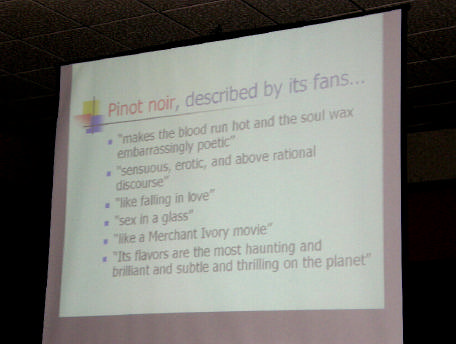
Annie Bones, State Relations Coordinator, The Wine Institute, San Francisco State wine shipping regulations vary considerably from state to state and are still being actively legislated in many states. If you have questions, consult Annie Bones at abones@wineinstitute.org or visit the website at www.wineinstitute.org, where a state-by-state carrier status listing is available on the Wine Institute website. Lets keep praying for as much reciprocity as possible.
Dr. Andy Walker, University of California Davis Department of Viticulture and Enology, Vitis vinifera is one of the most drought tolerant and lime-salt tolerant Vitis species. There are a variety of rootstocks available, all offering differing amounts of vigor, varying degrees of resistance to phylloxera, shallow or deep roots, and varying nematode resistance. Dr. Walker, a professor and geneticist at University California Davis has been working over fifteen years to develop five new rootstocks that are resistant to nematodes, aphids and other insects. The rootstocks have been licensed for eventual sale (2010) by certified nurseries to vineyards. It is hoped that the new rootstocks can be grafted to vinifera vines that are susceptible to these pests. Currently, Walker is recommending that vineyards be planted to multiple rootstocks that are appropriate to the site, particularly ones that are pest and drought resistant.
Jessica Cortell, Premier Pacific Vineyards, Ginny Lambrix Viticulturist (De Loach, Ball Wines) A few observations came out of this excellent discussion about realizing Pinot Noir’s phenolic potential through viticulture.
* Low vigor is associated with darker wine color and increased tannins * The management of tannins has become critical in viticulture as consumers look at texture as one of the most important determining factors in evaluating the quality of Pinot Noir. * Balanced vines deliver better flavors at lower Brix * Indigent or native fermentation produces more esters and thus a bigger bouquet * Biodynamic/organic farming creates a tremendous amount of life form in the top soil - a teaspoon of soil contains one million bacteria, several yards of fungal hyphae, many protozoans, and nematodes. * Biodynamic/organic farming helps balance the vineyard, supports biodiversity and competition, makes vines tougher and better buffered for tough times, and forces the grower to do cultural practices on times.
Post Conference Barbecue
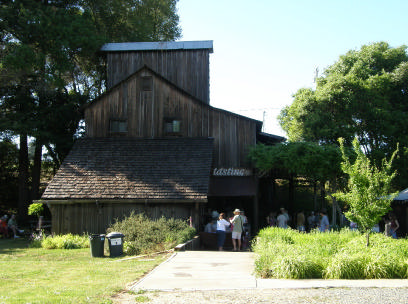
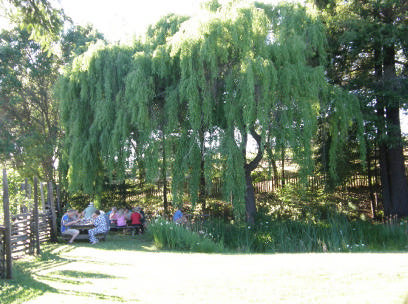
Grand Tasting of Anderson Valley Pinot Noir
The Anderson Valley’s validation as a premium grape-growing area was first established by Roederer Estate in the early 1980s and subsequently by Schraffenberger. Both made stellar sparkling wines from clones planted for their value in making bubbly. In recent years there has been an emphasis on cultivating Pinot Noir clones appropriate for still wine and widespread adoption of modern viticulture advances. The result has been that the current class of Anderson Valley Pinot Noirs can hold their own with any appellation in California. Winemakers and the trade seem to realize it, but the public perception has lagged. With the small number of wineries and the anti-development attitude that pervades the valley, recognition has been slow in coming. Retirees and urban refugees who are seeking the wine lifestyle won’t find the creature comforts of Napa or Sonoma in Anderson Valley. Many visitors to the valley simply pass through on their way to the Mendocino Coast, stopping only at a few visible tasting rooms. Be advised, however, that this region and its marvelous wines are worth exploring and I would encourage you to visit, lounge and really chill out a few days, and see what Pinot Noir can really do here.
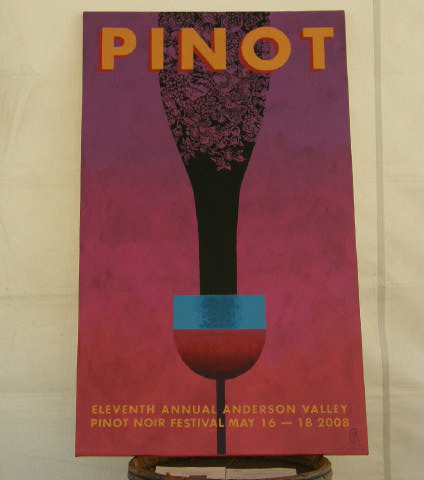 The Pinot Noir wineries of Anderson Valley are profiled in the following pages. Because of the heat on the day of the Grand Tasting, I did not get to sample the Pinot Noirs from every producer present. For some of the ones I missed, I tasted their wines at home after the event. In addition, I tasted a number of releases from wineries outside the Anderson Valley who source grapes from within the appellation. Like any appellation noted for Pinot Noir, there is a multiplicity of styles ranging from wines that are forward and drinkable upon release to ones that need years to uncover deep-seated complexities that lie within. There is something for everyone in the valley. Most of the producers' Pinot Noirs are very sensibly priced and are worth pursuing. If you visit, be prepared to make an effort, as some wineries are hidden in the hills several miles from the main thoroughfare and only reachable by lengthy, but scenic, dirt roads.
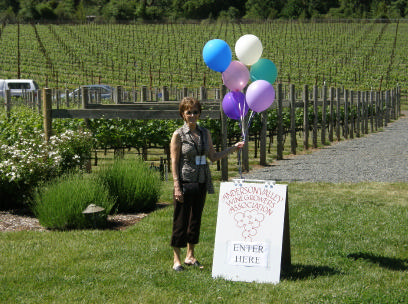
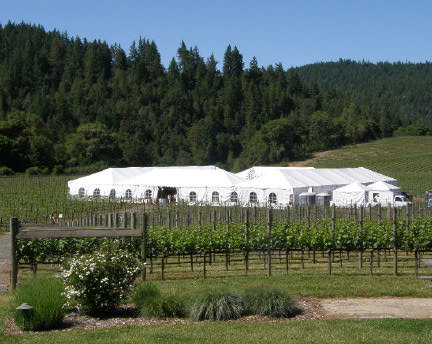
Wineries in Anderson Valley and Mendocino Ridge*To locate the wineries, refer to the map in previous article. * The Mendocino Ridge AVA is located just west of Anderson Valley. It consists of a scattering of tiny vineyards and a few wineries on ridges above the fog line at a minimum of 1,200 feet elevation. About 75 acres are planted, primarily to Zinfandel which has a history here dating back to the late 1800s. In recent years, a few Pinot Noir producers have put down roots in the Mendocino Ridge AVA in the town of Elk.
 Baxter Winery Phil Baxter (photo right) is a native Californian who studied winemaking at Fresno State and began his career in 1969 with Bill Bonetti of Charles Krug Winery. He became the head winemaker at Rutherford Hill for its first ten years and later moved to Dry Creek Valley to head the winemaking team at Domaine Michel. In 1989, he started his own Philippe-Lorraine label honoring his French maternal grandparents, Philippe and Lorraine Segrais. Phil Jr. grew up around wineries and vineyards and studied winemaking at University California Davis. After graduating, he worked in Burgundy, including time at Domaine de la Vougaraie. In 2003, father and son started the Baxter label concentrating on Pinot Noir. Two vineyard Pinot Noirs are produced from purchased grapes: Toulouse Vineyard in Anderson Valley and Oppenlander Vineyard in Comptche, just north of Anderson Valley. The 2004 ($40) and newly released 2005 vintages ($50) are available through retail channels and the website at www.baxterwinery.com. 28000 Greenwood Rd, Elk. 707-877-3727. Not open to the public. Black Kite Cellars Don and Maureen Green purchased a property in 1995 located in the coolest part of the “deep end” of the Anderson Valley overlooking the Navarro River and only eight miles from the Pacific Ocean. They developed a vineyard consisting of three 4-acre blocks planted to Pommard and Dijon 114 and 115 clones. The Greens are avid ornithologists and have named their Pinot Noirs after the beautiful black-shouldered kite (hawk) which is an endangered species in the Anderson Valley. The hawk has distinctive penetrating red eyes which are portrayed on the gorgeous Black Kite label. The viticulturalist is veteran Paul Ardzrooni and the winemaker is Jeff Gaffner, a talent who has made wine for over twenty years and has his own label, Saxon-Brown. The Pinot Noir lineup for 2006 includes Kite’s Rest Pinot Noir ($38) which is a blend of all three blocks in the Kite’s Rest Vineyard, and block-specific Stony Terrace Pinot Noir ($48), Redwoods’ Edge Pinot Noir ($48), and River Turn Pinot Noir ($48) from the same vineyard. Total production is less than 800 cases. The wines are sold on the website (www.blackkitecellars.com) and there is limited retail distribution. Not open to the public. 415-923-0277. The 2005 vintage was highly lauded by the wine press and you should take a serious look at the 2006 releases.
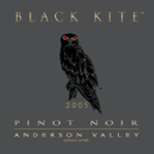 2006 Black Kite Kite’s Rest Anderson Valley Pinot Noir 14.76% alc., <500 cases, $38. · This wine draws you in with terrific black cherry, dark chocolate and spicy oak scents. Richly layered with dark fruits including plum with a nice sidecar of oak. Velvety in texture, clean, and beautifully composed. This one captures both the power and finesse of Pinot Noir. Everything you could want and some things you didn’t know to ask for. Flat out terrific.
Breggo Cellars This is a relatively new producer who has burst on the scene in Anderson Valley. The name, Breggo, comes from the boontling term for sheep. Douglas Ian Stewart and his wife Lucia Benitez-Stewart came to Anderson Valley in 1996 and purchased a 203-acre sheep ranch on Highway 128 just south of the town of Philo. At one ime, the ranch was part of the sprawling Rawles Ranch, a 4,000-acre property homesteaded by the Rawles family in the 1850s. Stewart was a businessman who had grown up in Sonoma and was convinced that cool and marginal sites produced the best wines. Knowing that sheep and grapevines flourish in areas considered climatically and geographically undesirable, Stewart laid down his roots. He renovated the house on the property, built a small winery and in 2005 began to source premium grapes from high-profile Anderson Valley vineyards including Savoy, Ferrington, Donnelly Creek, Aldersprings and Wiley. He hired a consulting winemaker, Ryan Hodgins, from Hanzell Vineyards in Sonoma. Hodgins has an interesting background. Originally from Oregon, he is a University California Davis graduate whose mentor was Bryce Bagnall of Bryce Vineyard in the Willamette Valley of Oregon. In 2005, he made wine in India before arriving at Hanzell. His wife is a viticulturalist at Chehalem in Oregon. Stewart purchased the latest in gentle winemaking technology, including the first-of-its-kind Coquard Bucket Press invented by Anderson Valley’s own Michel Saigue. The winemaking regimen consists of a 7 to 8 day cold soak, long fermentation lasting an average of 24 days, and aging in 50% new oak. 65% of the winery’s production is Pinot Noir. Recently, Stewart has begun to plant a vineyrd on his property. He plans to use an innovative and largely untried subsurface irrigation system. The winery and tasting room are at 11001 Highway 128, Boonville. The tasting room is open from 11-5 daily. 707-895-9589. The wines may be purchased on the website at www.breggo.com or through retail channels. The 2006 lineup of Pinot Noirs includes an Anderson Valley appellation Pinot Noir, and vineyard-designates from Savoy, Ferrington and Donnelly Creek.
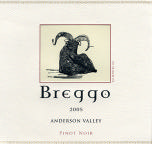 2006 Breggo Cellars Anderson Valley Pinot Noir 14.5% alc., $40. · Complex aromatic profile featuring cranberry, rhubarb, sage and alcohol. Some pleasing elegance to the texture and structure, but the heavy-handed oak overwhelms the darkly fruited core and spoils the experience
2006 Breggo Cellars Donnelly Creek Vineyard Anderson Valley Pinot Noir 14.5% alc., $55. · Reticent, but pleasant nose of spiced black cherries. Plush and creamy on the palate, tasting of plum reduction sauce. Fine tannins, clean finish. I like this one a lot.
2006 Breggo Cellars Ferrington Vineyard Anderson Valley Pinot Noir 14.5% alc., $55. · A decent earth-driven Pinot that features dark Pinot fruits that are light on the palate. Alcohol peaks out on the nose and finish.
2006 Breggo Cellars Savoy Vineyard Anderson Valley Pinot Noir 14.6% alc., $55. · .Muted aromas of dark fruits, oak and a whiff of alcohol. Beautiful core of plump dark cherries and blackberries. Dry finish, but not dried out. Clean and pure and immensely satisfying. The pedigree of this vineyard shows through..
Brutocao Cellars The Brutocao family was originally from Italy, and after immigrating to California, married into the Bliss family of farmers. Irv Bliss bought his Anderson Valley property in the mid- 1940s, and the family began making wine in 1991. The label features the Italian Lion of St. Mark, a symbol of family tradition and quality. Brutocao Cellars produces over twenty estate wines from its 450 acres of vineyards in the southern areas of Mendocino County. The winemaker is Fred Nickel. The Brutocao “Wine Center” in Hopland is a 7.5-acre wine and food complex at the site of an original school building dating to the 1920s. The Brutocao Schoolhouse Plaza includes a restaurant, tasting room, wedding pavilion, lawn concert area, banquet facilities and gift shop. A second tasting room on Highway 128 in Philo is inside a charming wood barn venue with a covered outdoor patio. The Pinot Noirs are crafted from Brutocao vineyards in Anderson Valley. The wines are available in the winery’s two tasting rooms and online at www.brutocaocellars.com
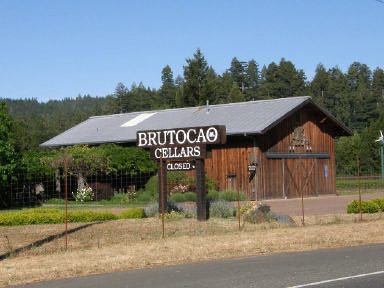
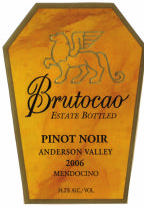 2005 Brutocao Riserva d’Argento Anderson Valley Pinot Noir 450 cases, $38. · Black cherry is front and center in this wine. Plum, wild berry, and oak flavors add complexity. Well-concealed tannins, silky in the mouth, and nice lift on the finish.
2006 Brutocao Anderson Valley Pinot Noir 1,1770 cases, $26. · The nose is enticing with black cherry, smoky oak and forest floor scents. A decent and easily approachable Pinot Noir that is sensibly priced and a welcome companion at any table.
Claudia Springs Winery Bob and Claudia Klindt purchased the 20-acre property and winery where Milla Handley crafted her first wines before later founding Handley Cellars at the former Homes Ranch close by. Along with partner, Warren Hein, they purchased an adjacent undeveloped 20-acre plot. Bob Klindt had been a home winemaker for several years and began producing wines under the Claudia Springs label while still living in the San Francisco Bay area. He concentrated initially on Zinfandel because Pinot Noir grapes were hard to come by. After moving to Anderson Valley, he made his wines in a rudimentary and tiny winery under the hillside home on the Klindt property. His wines were well received and consistently won medals in every vintage since the first in 1989. The Hein family eventually sold their share in the venture. Along with other family members, the Klindts planted 8 acres of Pinot Noir on the property in 1998 (Klindt Vineyard), and released their first Pinot Noir from the estate vineyard in 2001. The clonal selection is Pommard and Dijon 113, 115, 667 and 777. Winemaking is traditional using native yeasts and 30% new French oak. Very small quantities of other varieties including Zinfandal, Petite Sirah, Pinot Gris, and Viognier are also produced. If you get the opportunity, visit with Bob as he has a wealth of knowledge about Anderson Valley and can wax for hours about the many humorous tales of his winemaking career there. A tasting room (at 1810 Highway 128 at mile marker 16 next to the Rock Shop) in Philo is open primarily on weekends (11-5 Friday through Monday in summer and Friday through Sunday in winter). The tasting room is shared with Harmonique, whose wines are also crafted by Bob Klindt. Claudia Springs wines are sold through the tasting room. There is a Mendocino Pinot Noir which is primarily Klindt Vineyard fruit and a Klindt Estate Pinot Noir which is the flagship wine of Claudia Springs. The website is www.claudiasprings.com and the phone is 707-895-3993. The 2006 Pinot Noirs have not been released.
 2006 Claudia Springs Klindt Estate Anderson Valley Pinot Noir A young wine tasted briefly at the Grand Tasting. Fine texture, integrated tannins and a lively acidity on the finish. Bob’s wines are built for the long haul - I had a 1996 vintage of this wine at lunch at the event on Friday and it was startling fresh and tasty.
2006 Claudia Springs Klindt Estate Reserve Anderson Valley Pinot Noir Like an honest reserve bottling, this is a step up. Deep on the palate and packed with sweet cherry fruit, my brief taste left a lasting impression. A wine to fawn over.
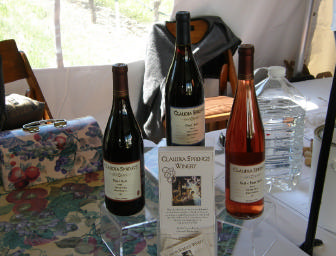 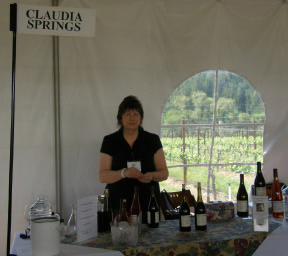
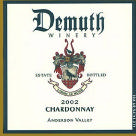 Demuth Winery Chris and Lyn Demuth farm 8 acres of Pinot Noir and Chardonnay in the hills just north of Boonville. The vines are 19 years old and planted at 1,600 feet, one of the highest vineyards in the region. The clones are Pommard and Wädenswil. Small quantities of Chardonnay and Pinot Noir are produced under the Demuth label, but most of the grapes are sold to boutique wineries including Adrian Fog, Ant Hill Farms, Skewis, and Whitethorn. Tours and tasting are by appointment. Chris is a very enjoyable man and if he likes you and sees a passion for wine in your eyes, you will be treated well. A bumpy dirt road leads to the property so plan accordingly. 16125 Deer Meadows Rd, Boonville. The website, www.demuthwinery, contains basic information only. I believe the latest release is the 2004 vintage. The wines are sold directly to visitors and through the website. 707-895- 3729. Drew Jason Drew has been involved with wine as far back as 1980 when he helped his uncle plant a vineyard in the Napa Valley. He received his winemaking education in both California and Australia and made his first wine in 1991. With his wife, Molly, he formed his own label while he was Associate Winemaker at Babcock Vineyards and Winery in the Ste. Rita Hills appellation. In 2003 he left to devote his energies full-time to the Drew label, and in 2004 the couple purchased a ridge top property in Elk, overlooking the Anderson Valley and only three miles inland from the Pacific Ocean. A winery was built on the property and an estate vineyard is planned for the near future. Molly is actively involved in managing the winery’s business affairs as well as assisting in winemaking, often offering her opinions on blending decisions. Currently, grapes are sourced from Santa Barbara County (Cargassachi-Jalama Vineyard, “Potbelly Block”), Anderson Valley, Sonoma Coast (McDougall Ranch), and the Yorkville Highlands (Weir Vineyard). The wines are quickly sold through a mailing list with some retail and restaurant distribution. Jason is a talented and affable young winemaker who is poised for big-time success. Tasting by appointment. The winery mailing address is PO Box 313, Elk, CA 95432, and the phone is 707-877-1771. The website is www.drewwines.com.
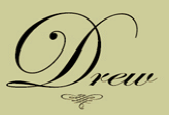 2006 Drew Fog-Eater Anderson Valley Pinot Noir 13.9% alc., 495 cases, $42. This wine is made from sites heavily influenced by the coastal fog. Fog- Eater is a boontling term used to describe a coastal dweller, someone living out on the margin. The blend varies with each vintage. In 2006, the blend is 65% Valenti vineyard (clone 667) and 35% Monument Tree Vineyard (clones 115,667,777). Four day cold soak, 20% stem retention, gravity racked two times, barrel aged in 35% new French oak and 65% seasoned French oak for 11 months. · Attractive ruby color. Flamboyant aromatics sporting spiced cherries, watermelon, freshsawn oak and a little barnyard. Plenty of lovable Pinot fruits, fine-grained tannins, admirable acidity, and a velvety texture. Doesn’t have the twinkle that the 2005 vintage had, but perfectly fine in its own right.
 Elke Vineyards Proprietor and winegrower Mary Elke represents much of what is good about Anderson Valley. She is a most charming woman, part farmer, part wine lover, and clearly a proud spokesperson for Pinot Noir. She began her farming career growing organic apples and making apple juice. She still sells 50+ cases of each year. Her 60-acre Donnelly Creek Vineyard is just east of Boonville and has supplied grapes to many notable wineries including Mumm Napa, Roederer Estate, Radio-Coteau, Copain, Londer, Au Bon Climat, ICI/La Bas, and Breggo. Since 1997, she has produced a vineyard-designate Pinot Noir, Blue Diamond Donnelly Creek Anderson Valley Pinot Noir crafted by winemaker Tom Farella. This is a sophisticated Burgundian-styled wine of great breeding. She also releases a Mary Elke Pinot Noir ($26) which is a value-priced wine composed of Donnelly Creek and other vineyard sources in the Anderson Valley. It is crafted in a big, fruity style popular with many drinkers in California. A Mary Elke Chardonnay and Rosé fill out the lineup of 1,700 cases. The wines are sold on the website at www.elkevineyards.com. Tasting is by appointment. 707-246- 7045.
 2006 Elke Vineyards Blue Diamond Donnelly Creek Anderson Valley Pinot Noir 14.1% alc., 650 cases, $38. · This is a beautifully balanced wine of great interest and charm. The nose offers concord grape, barnyard and hay aromas. Showy dark fruits are encased in earth and mushroom flavors which are filled out with a deft touch of oak. The wine grows in the glass, offering a blanket of fruit but an appealing restraint that leads to softness and finesse.
Esterlina Vineyards & Winery The Esterlina estate Pinot Noir vineyard sits on a ridge commanding a sweeping view of the Anderson Valley. This property was the site of the former Pepperwood Springs Winery. Purchased in 2000 by the Sterling family, the estate was rechristened Esterlina (Spanish for sterling). The Sterlings have successfully diversified their vineyard holdings and now produce several outstanding wines from Sonoma and Mendocino counties in addition to Pinot Noir. The Sterlings own vineyards in the Russian River Valley (Chardonnay and Pinot Noir), in Alexander Valley (Cabernet Sauvignon), and in Mendocino (Cole Ranch). Cole Ranch is the smallest AVA in the United States at 253 acres, and one of the few AVAs with one owner, Pinot Noir, Riesling, Merlot, Cabernet Sauvignon are farmed here but the Riesling is the superstar and Esterlina’s Cole Ranch Riesling is among the finest made in America.. Esterlina has also partnered with Everett 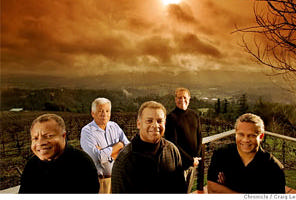
 2006 Esterlina Estate Anderson Valley Pinot Noir 14.2% alc., 611 cases, $45. 16 months cooperage in 40% new oak. Unracked, whole berry. · The nose is enchanting featuring plenty of cherry and spicy oak perfume. Silky in the mouth, with a panoply of red berry and stone fruits and a memorable finish.
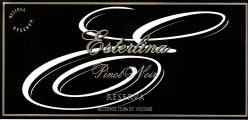 2006 Esterlina Reserva Anderson Valley Pinot Noir This one is still a baby and won’t be released until the Fall. It is going to be quite memorable. Grab some for your cellar when it is available.
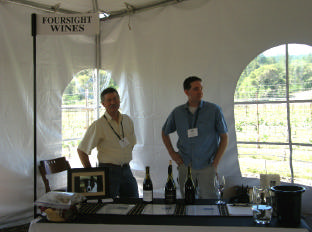 Foursight Wines This producer is a fresh face in the Anderson Valley, hatched in 2007 by Bill and Nancy Charles, long-time winegrowers, and daughter Kristy Charles and her fiancé Joseph Webb. The photo, taken at the event, shows Bill on the left and Joseph on the right, proudly pouring their Pinot. The name signifies both the number of generations of family that have lived and worked on one piece of land in Anderson Valley, and the foresight to provide a livelihood for future generations of the family. The Charles clan arrived in the Anderson Valley in 1943 to join the regional lumber boom. In 1950, they purchased property just east of Highway 128 in Boonville, built a sawmill, and Charles Lumber Company was born. The Charles family still resides on this property. Life in the Anderson Valley back then could be challenging, to say the least. In the 1950s, fighting was popular, and one of the local bars was appropriately named Bucket of Blood. Because of the lumbar industry, amenities in Boonville exceeded those of today and included a movie theater, pharmacy, and bank. Bill Charles was raised in the valley, educated at Chico State, and after marrying Nancy Wilson, moved back to the family land in Boonville. Bill and Nancy became involved in farming and planted Charles Vineyard in 2001. The vineyard consists of 15 acres of Pinot Noir, Sauvignon Blanc and Semillon. The grapes have been sold to several wineries including Navarro Vineyards and Handley Cellars in Anderson Valley, Pinot Noir specialist Papapietro Perry in the Russian River Valley and Schramsberg in Napa Valley. After college, daughter Kristy moved back to Anderson Valley with her fiancée, Joseph Webb. Foursight Wines was launched in 2007 with Joseph handling the winemaking duties. Joseph received a degree in wine business from Sonoma State University and worked during college at Sebastiani and Landmark Vineyards. Later, while he was an assistant winemaker at Joseph Swan Vineyards, he and Kristy made home wine in their Santa Rosa apartment. The first Charles Vineyard Pinot Noir was proudly crafted in 2004. Joseph now works at Londer Vineyards in the Anderson Valley in addition to his duties at Foursight Wines. Kristy is the Executive Director of the Anderson Valley Winegrowers Association and largely responsible for the success of this year’s Pinot Noir Festival. Bill Charles has designed and is building a winery and tasting room for Foursight Wines. The lumber for the structure was grown, harvested and milled on the Charles family ranch. The tasting room will be constructed from a burl wood also recycled from the family ranch. The building will sit adjacent to a 100 year-old apple orchard on the property, close to Highway 128 in Boonville. The Charles family are dedicated and warm people who welcome your interest and inquires. To purchase Foursight wine, contact Kristy Charles at 707-895-2889.
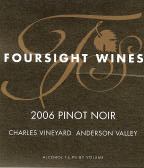 2006 Foursight Wines Charles Vineyard Anderson Valley Pinot Noir 14.9% alc., 600 cases, $46. Clones are Pommard 5, 114, 115 and 777 planted on an ancient river bed which is well-drained and can withstand the annual rainfall of 41.6 inches in Boonville. Wild yeast primary and secondary fermentations, aged in 33% new French oak. A 2007 barrel sample was also tasted at the Festival and it was a knock-out with a terrific core of cherry fruit. Stay tuned to this producer, join the mailing list, and look for big things in the future. · Moderately light crimson color. Red fruits, savory herbs and forest floor aromas. Red fruit-driven with cherry, cranberry and cola flavors. Light in character, the soft tannins make for an easy drinker. The alcohol barely peaks out.
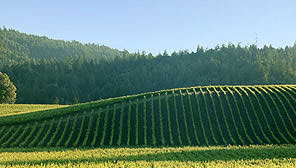 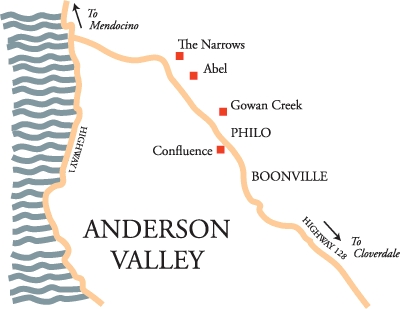 came from winemaking stints at Stag’s Leap Wine Cellars and Husch to head up the Pinot Noir program at Goldeneye. He is assisted by vineyard manager Nathan Miller, a fifth generation Californian with a family history of farming going back to the state’s original pioneers. Goldeneye now sources fruit from twelve different vineyards (four are owned and handfarmed by Goldeneye - see map left) for its “house style” estate bottling. Rasmussen gets to work with 49 different clonal and rootstock combinations of Pinot Noir planted in 80 separate blocks. In 2004, single vineyard Anderson Valley Pinot Noirs were added to the Estate and Migration bottlings. Goldeneye favors a large percentage of new French oak, ranging from 50% for Migration Pinot Noir to 95% for Confluence Vineyard Pinot Noir. The tasting room is adjacent to an old apple drying barn on Highway 128 and offers both indoor and outdoor seating. The hours are 11-4 daily. Fridays and Sundays at 11:00 AM there are complimentary tours of the Confluence Vineyard including a tasting of sample lots from each block our of barrel prior to tasting the prior vintage’s finished wine. Tuesdays and Thursdays at noon, Goldeneye offers a semiprivate tasting of limited-production wines, paired with a selection of cheeses ($20). The phone number is 707-895-3202 and the website is www.goldeneyewinery.com. The latest releases are the 2005 Goldeneye Anderson Valley Pinot Noir ($55), 2006 Migration Anderson Valley Pinot Noir ($32), 2005 Goldeneye Confluence Vineyard Anderson Valley Pinot Noir ($75), and 2005 Goldeneye Gowan Creek Vineyard Pinot Noir ($75). Magnums are available. The wines are largely sold through a mailing list and at the winery with some retail distribution.
2004 Migration Anderson Valley Pinot Noir 14.5% alc. 4.440 cases, $32. · The pleasant nose opens to cherries, savory herbs and oak with swirling. Substantial darker fruits are featured which are highlighted by a hint of spice. The mouth feel is soft and appealing. There is plenty of oak running through, maybe a little too much on the slightly bitter finish.
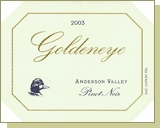 2004 Goldeneye Anderson Valley Pinot Noir 14.5% alc., 7,258 cases, $52. · Definitely a step up in quality and complexity. Showy aromatics of cassis, black cherry and forest floor. Demure dark fruits, particularly black raspberry, with an earthy edge and nicely integrated oak. Creamy, smooth and clean. Balance is spot on.
Greenwood Ridge Vineyards Based on the Mendocino Ridge (see history, page 6), this venerable winery has been producing multiple varietals since 1980. The winery’s tasting room is a valley landmark and can be easily spotted by the colorful flags waving in the breeze at the entrance and the large solar panels adjacent to the winery. The panels have been supplying all of the electric power needed for the winery since 2005. This is a special spot for a picnic. The wines are bottled with a unique etched design on the front instead of a label. The tasting room address is 5501 Highway 128, Philo. Only small amounts of Pinot Noir are made from the winery’s vineyard on Mendocino Ridge and is sold on the website. The phone is 707-895-2002 and the website is www.greenwoodridge.com
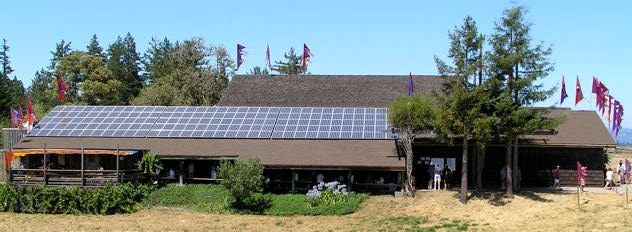
 2006 Greenwood Ridge Mendocino Ridge Pinot Noir 14.1% alc., 750 cases, $27. · This is a vivid wine with appealing red berry fruits and a swirl of spice. Refreshing, easy to drink, and a steal at this price.
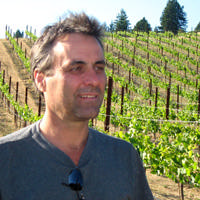 Gryphon Wines Jonathan O’Bergin (pictured) has owned the 120-acre Larklinn Ranch in Anderson Valley since 2000 and currently farms 7 acres of Pinot Noir there. The Larklinn Vineyard is located in the “deep end” of the valley between Philo and Navarro. The property, which is surrounded by towering redwoods, has a century-old fruit orchard, and barns built by John Guntley in 1912. Jonathan is a native Californian whose interest in wine began seriously when he met Colin Fenton MW while traveling through Champagne. He began importing California wines to England and in 1980, his Alexander Valley Chardonnay selection won a Gold Medal at the World Wine Fair in Bristol, England. In the 1980s he settled in Anderson Valley and planted his first Pinot Noir in 1987 after “falling in love with Clos de la Perrier Fixin in Burgundy.” He made his first Anderson Valley Pinot Noir in 1989. Stephen Bellamy, whom I met at the festival pouring Gryphon wines, is a native New Zealander who met Jonathan in 1975 on the Island of Rarotonga in the South Pacific. Stephen eventually moved to California and settled in the Santa Cruz Mountains where he worked at David Bruce Winery. He joined Gryphon in 2003 to assist in winemaking and management of the winery. Winemaking is traditional and is Burgundian inspired. The wines are sold on the website at www.gryphonwines.com. No tasting room, but Jonathan and Stephen welcome visitors - 831-277-3849. O’Bergin is married to Marie Johnston whose French mother bestowed on her an interest in food and wine. She offers her own line of imported wines. Jonathan and Marie have two properties in France for rent: an apartment in Paris and a residence in Bordeaux. They also pen a travel blog available through the website. All wines were poured at the festival.
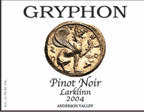 2003 Gryphon Larklinn Anderson Valley Pinot Noir Perfectly fine aromatics and flavors. Appealing elegance and balance.
2004 Gryphon Larklinn Anderson Valley Pinot Noir 14.7% alc. $45. · The heat in the tent seemed to exaggerate the alcohol in this wine. The nose featured attractive berry jam aromas. Plenty of stuffing on the palate with moderate tannins that still need to be shed. Showed better when tasted last year.
2005 Gryphon Anderson Valley Pinot Noir $30. Usually this wine is 100% estate fruit but in this vintage some Santa Lucia Highlands grapes were added in. · This was the most showy wine of the three. A great core of fruit with ever-expanding flavors.
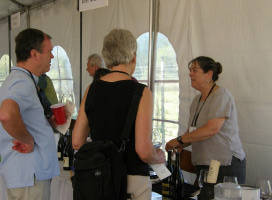 Handley Cellars Established in 1983, this winery is one of the few in California in which both the owner and winemaker are the same woman. Milla Handley (pictured right with distinguished guest of the festival, John Haeger, author of North American Pinot Noir) started out very modestly with 250 cases of Chardonnay made in her home basement in 1982. Together with now deceased husband, Rex S. McClellan, she acquired a 59-acre estate on Highway 128 in Philo and built Handley Cellars into a renowned winery producing 20,000 cases of several varietals annually. Along the way, she became a role model for aspiring female winemakers and a spokesperson for the Anderson Valley. Her emphasis on sustainable farming influenced many other winegrowers in the valley. Mille is the great-granddaughter of the owner of the Blitz-Weinhard Brewery in Portland, Oregon. Raised in the San Francisco Bay area, she studied at University of California Davis, but realized early on that winemaking suited her more than large-scale beer production. After schooling, she studied under Richard Arrowood at Chateau St. Jean. After moving to Anderson Valley in 1978, she mentored under wine master Jed Steele at Edmeades. Planting of her estate vineyard began in 1986 and continued up until 1999, now encompassing 30 acres. There are 12½ acres of Pinot Noir in addition to Chardonnay and Gewürztraminer. She also farms vineyards in the Dry Creek Valley of neighboring Sonoma County (Chardonnay, Sauvignon Blanc, Viognier and Syrah) and the 7½ -acre RSM Vineyard surrounding her Anderson Valley home that was planted in 1999 and 2001 (Pinot Noir and Pinot Gris). Her charming tasting room is filled with her family’s collection of Oxacan, Indian, and African folk art and includes a serene sculpture garden for picnicking. The tasting room is open daily and the staff is most friendly. Milla is assisted in the winemaking chores by Kristen Barnhisel who studied at University California Davis and has worked at several wineries. The wines are sold through the website at www.handleycellars.com and to Cellar Club members who receive an excellent newsletter in booklet format. Additionally, there is good distribution of Handley wines to restaurants and retail stores. The winery is located at 3151 Highway 128, Philo. 1-800-735-3151. Gaze on these photos of the picturesque Handley property and you will see how dreamy the Anderson Valley can be.
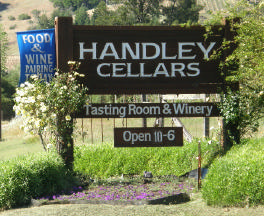 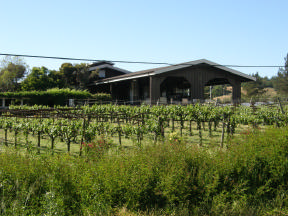
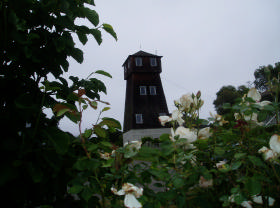 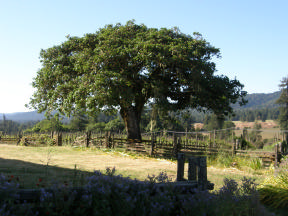
2003 Handley Cellar Estate Vineyard Anderson Valley Brut Rosé $36. · A medal-winning sparkling wine with a lovely dark pink hue, fine bead, tangy strawberry and raspberry flavors with a touch of lemon peel and bracing acidity on a refreshing finish.
2004 Handley Cellars Reserve Anderson Valley Pinot Noir 14.5% alc., $52. · This is a wine of great interest. It starts off with black fruits, savory herbs, plenty of barnyard and some oak aromas. In the mouth it is earthy and primal with deep, dark fruit. Beautifully crafted, the wine offers a velvety texture and reigned-in tannins. Smooth as a baby’s bottom. Pure Pinot pleasure.
2005 Handley Cellars Anderson Valley Pinot Noir 14.5% alc., 4,062 cases, $28. A blend of multiple vineyards including Handley Estate, Ferrington, Charles, Helluva, Corby, and Romani. Aged 9 months in 29% new French oak. · Dark cherry driven with sandalwood, earth, and dark chocolate highlights. Quite tasty and easy to like.
 2005 Handley Cellars RSM Vineyard Anderson Valley Pinot Noir 100 cases, $52. The first vineyard-designate wine from Milla Handley from her home RSM Vineyard named after her late husband. Clones are Pommard, 115 and 667. · This is a very rich and exotic Pinot Noir that defies adequate description. Firm and medium structured with full flavors. Black cherries, game, mocha, and tea flavors make an appearance. Built for aging and contemplation.
Harmonique In 2002, veteran Anderson Valley winemaker Bob Klindt of Claudia Springs Winery teamed with Bruce Conzelman, a real estate developer and long-time Pinot Noir aficionado, to produce Harmonique, a Pinot Noir blend from Anderson Valley fruit. The two vineyards chosen were the Wiley Vineyard planted with 29 year-old vines in the westernmost reaches of the valley, and the 7 year-old Klindt Vineyard located a mile east of Wiley. While blending the various lots, two distinct wines emerged and were bottled separately: “Delicacé,” a feminine style, and “The Noble One,” a more opulent and structured Pinot Noir. The Harmonique wines have won numerous medals in competitions and I have included the 2004 vintage of both wines in my yearly All-American list. A third wine, the 2005 Harmonique “Elegancé,” will debut later this year first to Wine Club Members and then will be available on the web site and through selected retailers. Conzelman has acquired the Christine Woods Vineyard located in Philo where a winery is planned, and the Rose Family Vineyard, now renamed Conzelman Vineyard. The Harmonique wines are among my favorites from the Anderson Valley and I would urge you to try them. The very personable Moira Conzelman handles the marketing and pours at all events (see photo at this year’s festival) as husband Bruce has a hearing disability. Harmonique shares a tasting room with Claudia Springs Winery (see page 18). 800-937-1889. The website is www.harmoniquewine.com.
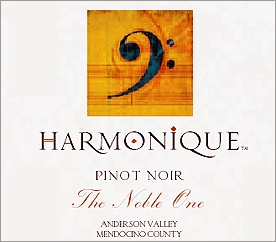 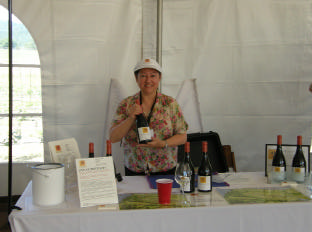
 Husch Vineyards As noted earlier in this issue, the Knoll Vineyard at Husch was the first planting of Pinot Noir in the Anderson Valley (1968). The Knoll Vineyard was planted to a Wente field selection of Pinot Noir and the first wine from this vineyard was made in 1971. Vineyard manager Al White has been at Husch since 1973, and current winemaker, Brad Holstine, has been on board since 2003. In the early years of The Knoll Vineyard Pinot Noir, the juice was blended at pressing, pumped over aggressively and subject to lees stiring. The resultant wines were tannic and aggressive and needed at least five years to come around. During the 1980s, attention was turned to tannin management using more barrel and bottle age. Currently, the winemaking regimen for the Knoll Vineyard Pinot Noir includes fractional whole clusters, short cold soaks, hand punch downs, secondary fermentation in barrel, bulldog racking, and 33% new French oak for 18 months. Husch also farms the 128-acre La Ribera Ranch (Cabernet Sauvignon, Zinfandel, Sauvignon Blanc, Chardonnay, Chenin Blanc) in the Ukiah Valley and produces 18 different wines. The current owners of Husch are the third generation Oswald family (Hugo Oswald, Jr. bought Husch in 1979), Zac Robinson and Amanda Robinson Holstine. Total production is 45,000 cases annually. Three Pinot Noirs are offered: an Anderson Valley blend, an Anderson Valley Reserve, and the Knoll Vineyard single- vineyard bottling. Husch’s tasting room is a small, quaint and weathered shack that once was a chicken coop. It is open daily, 10-6. The address is 4400 Highway 128, Philo. The wines are sold on the website at www.huschvineyards.com. 707-895-3216.
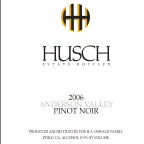 2006 Husch Vineyards Anderson Valley Pinot Noir 13.9% alc., 5,598 cases, $23. Aged 10 months in 25% new French oak. · This wine gives you a lot of bang for the buck. Always crafted in an elegant, easily approachable style, it has mouthwatering acidity. Red cherry and raspberry flavors are front and center with a sidecar of spice and Dr. Pepper.
2005 Husch Vineyards Knoll Anderson Valley Pinot Noir 425 cases, $38. 25% whole cluster. Aged 15 months in 50% new French oak. Not tasted. The wine is available on the website.
Jim Ball Vineyards Chicago attorney Jim Ball has thought about escaping the rat race ever since he visited Northern California 27 years ago. On a subsequent trip to the Anderson Valley he had his Pinot Noir epiphany. Blessed with plenty of financial resources and seriously dedicated to crafting world-class Pinot Noir, he has began Jim Ball Vineyards. Ball has teamed with noted winemaker, Greg La Follette, who has years of experience vinifying cool-climate Pinot Noir in California. Ball is currently building a 10,000 case state-of-the-art winery on property he purchased in 2005 across the street from the Goldeneye tasting room on Highway 128. The winery was designed by noted architect Howard Backen of Backen & Gillem and will be simple in design and respectful of the region. La Follette will also craft his own Tandem label wines at the winery. In addition to the winery, Ball has begun to plant 15 acres of Pinot Noir and Chardonnay on the land. This vineyard will be called FourDog Ranch. A second vineyard site in Anderson Valley was acquired previously in 2000. Located at a high elevation and rather remote, this vineyard, named Middleridge Ranch, was planted in 2002 (10 acres) and 2006 (16 acres). Eight different heritage clones on three different rootstocks are thriving in the Goldridge soil there. Ball has brought in biodynamic viticulturalist, Ginney Lambrix (she spoke at the Technical Conference - page 11), who has left De Loach, to supervise vineyard development. La Follete was the winemaker at De Loach and he will turn over the reigns to Brian Maloney and assume an advisory role there. The inaugural Pinot Noir from the Middleridge Ranch was introduced at the Anderson Valley Pinot Noir Festival. Other wines will follow as the vineyards mature. I am certain that the talent and commitment here is a strong predictor for success, and I believe it would show prudent foresight to sign up for the mailing list now. The website is www.jimballvineyards.com and phone 707-480-0371.
 2006 Jim Ball Vineyards “Signature” Anderson Valley Pinot Noir 14.5% alc.,$60. · This wine actually startled me by its charm. An impressive inaugural effort that showed great breeding. Gregarious red fruit and spice that delivered plenty of perfume and flavor, yet was light on its feet. The whole Pinot package.
Lazy Creek Vineyards The history of this winery was profiled on page 6. This winery is currently owned by Josh and Beth Chandler and David Noorthoek, M.D.. Chandler has a varied background including winegrower, trained chef, and landscape architect. The Chandlers have added to the original 19 acres of vineyards they obtained when they purchased the property in 1999, and now farm 20 estate acres. The original Pinot Noir plantings consist of multiple heritage and suitcase selections. Winemaking is unique in that post-fermentation a portion of the Pinot Noir is put into large oak casks. The tasting room at 4741 highway 128 in Philo is open by appointment. The small production is sold primarily at the winery. Lazy Creek has a well-deserved reputation for Gewürztraminer as well. The current Pinot Noirs offered for sale on the website are the NV Anderson Valley Pinot Noir ($21), the 2004 Estate R.P.B. Pinot Noir ($98), and 2006 Estate Old Vine Pinot Noir ($39.50). The estate wines are bottled in heavy glass with the Lazy Creek logo embossed in glass on the neck. The website is www.lazycreekvineyards.com and phone is 707-885-3623
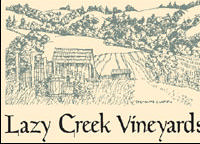 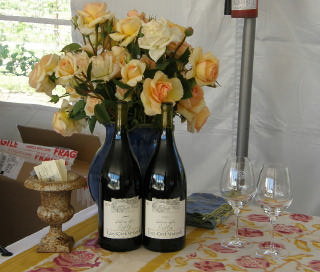 Londer Vineyards Larry and Shirlee Londer left a comfortable life in Albuquerque, New Mexico (he was an ophthalmologist who directed a large multi-doctor practice and she ran the optical shop) to farm grapes and make wine in the Anderson Valley. In 1999, the Londers teamed with a few investorfriends to purchase a bucolic farm property in Philo. Larry wanted to name the venture Anderson Valley Vineyards, but the name was already taken by a winery in Albuquerque of all places, and they wouldn’t relinquish it. The Londers planted a small estate Pinot Noir vineyard and sourced grapes from several vineyards in Anderson Valley and Sonoma County. Larry has a rye sense of humor and likes to detail the struggles that running a small boutique winery entails (“We work eight days a week and still don’t have enough time!”), but you sense that he is loving every minute of it. Winemaker Greg La Follette got them started, but a protégé of Greg’s, Richard Davis (Halleck, Alcina Cellars, Calstar, and La Czar) has taken over and doing a fine job. The Londer estate is stunning with a vineyard encircled by fruit orchards and towering redwoods. A winery is on the property and the Londers talk about opening a tasting room. For now, they receive visitors by appointment in their home or a guest cottage on the property. Shirlee (pictured below at the recent Festival) keeps the operation running smoothly. The wines are sold through a mailing list with some retail distribution. Londer wines have received numerous medals and are highly praised in the wine press. The wines are not bashful and feature copious fruit. The website is www.londervineyards.com and the phone is 707-895-3900.
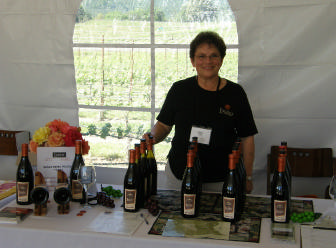
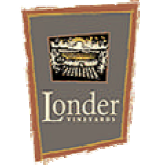 2004 Londer Vineyards Anderson Valley Pinot Noir 14.2% alc., $30. Made by Greg La Follette. · Aromas of crushed plums and buttered toast. A big and bold wine with a healthy tannic spine. Plenty of dark Pinot fruits which stand up to the alcohol.. Needs a steak.
2005 Londer Vineyards Anderson Valley Pinot Noir 14.3% alc., $33. Made by Greg La Follette. · Black fruits, toast and minerality on the nose. Oak-infused black fruits on the palate. Tannins are toned down compared to the 2004 vintage creating a soft and appealing mouth feel.
2005 Londer Vineyrds Paraboll Anderson Valley Pinot Noir 14.3% alc., $54. “Para” is an art classification for a deep cherry-red color. “Boll” translates as “great” in boontling. Sourced from Ferrington and Valley Foothills Vineyards. A reserve blend. · Complex and bright aromatic profile featuring black cherry, ripe strawberry, sage, vanilla and a little funk. A boat-load of herbal-toned dark fruits that are balanced and on keel. Some green tannins persist.
2005 Londer Vineyards Estate Grown Anderson Valley Pinot Noir 14.3% alc., $50. · Jammy blackberry and cherry fruit with a little barnyard on the entry. Big core of plush dark fruits with a delicious lingering aromatic berry finish. Smoky, spicy, exotic and very tasty. This one is captivating and forces you to take another sip.
2006 Londer Vineyards Corby Vineyard Anderson Valley Pinot Noir A “trainer” Pinot Noir that is light and delicate with tasty strawberry flavors. I call this “Londer Light.” · Ready to drink now and will pair will with roast chicken and lighter fare.
2006 Londer Vineyards Anderson Valley Pinot Noir 14.8% alc., $35. · A step up from the Corby bottling. A lot going on here including black cherry fruit, earth, smoke, and spice. Nicely put together and very satisfying.
2006 Londer Vineyards Paraboll Anderson Valley Pinot Noir 14.8% alc., $54. · You can drink it now but it would be infanticide. Shows great promise with ripe fruit aromas, a charming and intense dark berry core and coating tannins.
2006 Londer Vineyards Estate Grown Anderson Valley Pinot Noir Not released. · This sultry beauty is withholding its charms at present.. The aromatics are shy and the fruit is largely hidden by the tannic structure. Black tea, game, and cola flavors are evident. Very tight and concentrated.
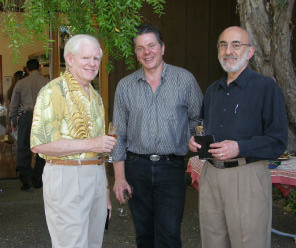
Navarro Vineyards Navarro’s historical place in the Anderson Valley was profiled on page 7. Navarro began planting grapes in the Anderson Valley in 1974. Almost twenty-five years later, the children of founders Ted Bennett and Deborah Cahn, Aaron and Sarah Cahn Bennett, are now actively involved in the winery as well. Sarah received a Masters degree in enology and viticulture from University California Davis, and has applied her research on the phenolics of Mendocino Pinot Noir to Navarro’s already stellar lineup of Pinot Noirs. She is assisting winemaker Jim Klein, who has been at Navarro for over fifteen years. Aaron designed Navarro’s first website in 1996, and his internet savvy adds to Navarro’s impressive marketing history. Navarro now produces 40,000 cases of wine annually, 10,000 cases of which are Pinot Noir. The winery farms nine vineyard sites and blends multiple lots of Pinot Noir prior to bottling each vintage. There are three Pinot Noirs produced: a Mendocino appellation blend, a Méthode a l’Ancienne Anderson Valley Pinot Noir, and a Deep End Anderson Valley Pinot Noir. The wines are sold primarily to a loyal customer mailing list and online at www.navarrowine.com. Some of the limited release wines are only made available to wine club members. The tasting room and winery are at 5601 Highway 128, in Philo. The tasting room is open daily 10-6:00 and the grounds are perfect for picnicking. Tours are offered daily at 10:30 AM. There is a full lineup including Chardonnay, Sauvignon Blanc, Riesling, Pinot Gris and Gewürztraminer. Pictured below is Jim Klein talking Pinot with Burt Williams at the Festival.
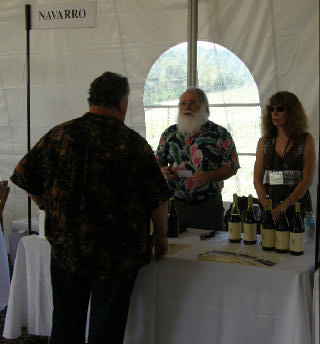
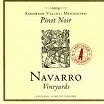 2006 Navarro Mendocino Pinot Noir $19. · An entry level Pinot Noir which is perfectly fine for what it is. Pleasant with lightly spiced red fruits and sparkling acidity.
2006 Navarro Methode L’Ancienne Anderson Valley Pinot Noir $29. · This is the flagship Pinot Noir which is widely available. Year in and year out it is consistently fine and this vintage is no exception. Perfumed with cherries, roses and tea, and both cherries and herbs leap out on the palate. Oak is deftly integrated. Beautifully crafted and harmonious, a terrific Pinot and one of the best tasted this Festival weekend. A steal at this price.
2006 Navarro Deep End Anderson Valley Pinot Noir $45. · Primarily pre-sold to wine club members. This one has the most backbone and structure and will reward patience. All the good stuff is there and worth joining the wine club to get your hands on some.
Phillips Hill Estates This winery has a very interesting background and is best read on the website with a glass of Pinot in hand. Briefly, owner and winemaker Toby Hill grew up in San Francisco and had a successful career in the art business in New York. Like so many who become attracted to a less harried lifestyle, he returned to California and found his piece of heaven in the hills overlooking Anderson Valley. He built a house and an adjacent art studio, but when some unfinished Pinot Noir became available, the studio was transformed into a winery and that year (2002) Hill released his first Pinot Noir. He now sources grapes from the Oppenlander Vineyard on Shandel Ranch in Comptche’s Surprise Valley (just north of Anderson Valley), and the Toulouse Vineyard in Anderson Valley. Interestingly, William Shandel planted fifteen different varietals in 1984 trying to determine which would perform best in his cool climate site close to the ocean. It wasn’t long before he decided on Pinot Noir and now supplies grapes to several producers as well as releasing his own Shandel Pinot Noir. Shandel now farms 18 acres of Pinot Noir, clones 114, 115, 667, Martini and Pommard, all self-rooted, planted in 1998-1999. Hill Estates wines are sold on the website at www.phillipshillestates.com. The winery is located at 25690 Philo Greenwood Road in Philo. Tasting by appointment. 707-877-1151. The labels are quite attractive, reflecting Hill’s artistic background. John Pope assists Hill in the winemaking duties. I was so taken by the wines when tasted briefly at the Festival, I ordered some as soon as I returned home so I could spend some time thoroughly enjoying them.
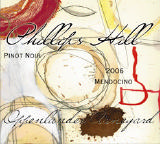 2006 Phillips Hill Estates Oppenlander Vineyard Comptche Mendocino County Pinot Noir 14.1% alc., 550 cases, $42. Aged 11 months in 40% new French oak. · Startling good from start to finish. Aromas of Bing cherry, grass and wet earth entice, followed by delicious bright cherry and berry flavors with an exotic bent that grows in the mouth. Silky, clean and perfectly composed with striking length. A very, very seductive Pinot.
 2006 Phillips Hill Estates Toulouse Vineyard Anderson Valley Pinot Noir 14.5% alc., 150 cases, $40. Hill calls this vineyard a “nursery for angels.” Clones 115, 667 and 2A. Aged 11 months in 35% new French oak. · The nose offers sexy cherry and cranberry scents with a whiff of alcohol peaking out. Richly layered core of black cherries, blackberries and cola that carry through to a finish that lasts an eternity. Soft and smooth in texture, but with finishing tannins that need to be shed. A bit backward now, but will reward another year in the bottle. Excellent.
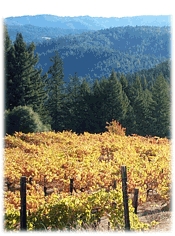 Philo Ridge Vineyards Fred Buonanno and Heather McKelvey searched for four years before finding their dream property high on a ridge in the Anderson Valley. After answering an ad in the newspaper, they fell in love with the 40+ acres and purchased the land in 1999. Far up in the hills on a 5.33 mile dirt road, the existing vineyard had been planted in 1976 to Cabernet Sauvignon and Merlot by the original owner, Vernon Rose of the now defunct Christine Woods Winery. Since the couple had no farming experience, they hired vineyardist Norman Koble to supervise the planting of Pinot Noir and Pinot Gris on the property. Their first vintage was 2001. Hovering around 1,000 case of multiple red and white varietals, they plan to eventually feature primarily Pinot Noir. Tasting is by appointment on weekends. Wines may be obtained by phoning 707-489-2303 or contacting the owners through the website at www.philoridge.com.
2004 Philo Ridge Anderson Valley Pinot Noir $28. Only a few cases left. · A very nice mature Pinot with secondary aromas of spice, cigar box, and leather. Red fruit driven with a touch of sherry evident.
 2005 Philo Ridge Anderson Valley Pinot Noir $32. Scheduled to be released soon. · Nice Pinot perfume including mineral-infused red cherries. Dry candy flavors with lively acidity. Needs a little time.
Raye’s Hill Vineyard and Winery Raye and Dan Sokolow are Chicago refugees who moved to Anderson Valley and planted their estate vineyard in 1997. They currently craft 1,000 cases of wine, primarily Pinot Noir, from their estate vineyard and several other vineyards in the valley. The wines are available on the website at www.rayeshill.com. 3400 Chardonnay Lane in Philo. 707-895-3439. I did not get to taste the wines. Currently available:
 2004 Raye’s Hill Anderson Valley Pinot Noir 14.3% alc., 495 cases, $24. A blend from four vineyards.
2004 Raye’s Hill Wightman House Vineyard Anderson Valley Pinot Noir 14.3% alc., 103 cases, $24. From a 2 acre vineyard in Boonville planted to Martini clone.
2004 Raye’s Hill Reserve Anderson Valley Pinot Noir 14.5% alc., 103 cases, $26. From Raye’s Hill Vineyard, Cerise Vineyard, and Wightman House Vineyard.
2005 Raye’s Hill Henneberg Vineyard Anderson Valley Pinot Noir 14.2% alc., 280 cases, $26. From a 14 acre neighboring vineyard.
Roederer Estate Since 1981, Roederer Estate has been developing its own vineyards and crafting fine sparkling wines. Jean-Claude Rouzaud, Chairman of Champagne Louis Roederer and grandson of Madam Camille Olry Roederer, chose the 58 acre Anderson Valley vineyard and winery site. Roederer Estate now farms over 580 acres of Pinot Noir (primarily sparkling clones 32 and 33, Pommard, and Dijon 667 and 777) and Chardonnay. All wines are made from estate grapes. The winery’s Anderson Valley Estate Brut (65,000 cases, $23) debuted in 1988, and in 1993 was joined by the first vintage sparkler, L’Ermitage (5,548 cases, $45). An Estate Brut Rosé (3,000 cases, $27) and vintage dated L’Ermitage Rosé 650 cases of 750 ml ($56) and 110 cases of 1.5 L, are also produced. The winemaking team is all French headed by Arnaud Weyrich. Roederer (Maisons Marques & Domaines) also owns nearby Schraffenberger Cellars (formerly Pacific Echo and originally Schraffenberger). Roederer Estate has quietly been making a still Pinot Noir since 1992, which is only sold through the tasting room. The barn-inspired tasting room is open daily from 11-5:00 PM at 4501 Highway 128 in Philo. The website is www.roedererestate.com. 707-895-2288. The sparkling wines are widely distributed.
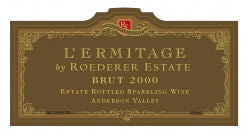 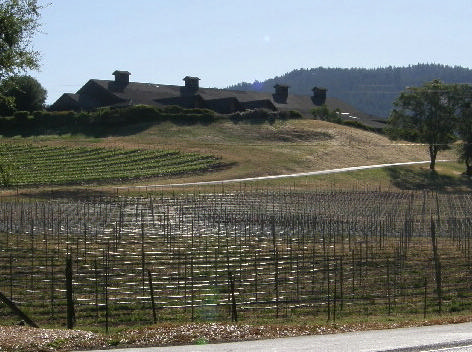 Scharffenberger Cellars Originally founded in 1981 by John Scharffenberger (who also subsequently started the Scharffenberger chocolate company now sold to Hershey), the sparkling wine producer was sold in 1998 and renamed Pacific Echo. It was acquired by Maisons Marques & Domaines (Roederer) in 2004 and the original name restored. Tex Sawyer has been winemaker here since 1989. A still Pinot Noir is produced and sold in the tasting room. The winery’s flagship wine is the NV Scharffenberger Brut (25,000 cases, $19). The tasting room is at 8501 Highway 128 in Philo and is open daily from 11-5. The website is www.scharffenbergercellars.com. 707-895-2957.
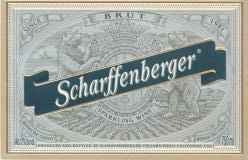 Standish Wine Company The winery’s historical perspective is discussed on page 17. The charming tasting room at 5101 Highway 128 in Philo is open daily starting at 10:30. 707-895-9213. The website is non-functional. I did not get a chance to taste the 2005 Standish Wine Company Day Ranch Vineyard Anderson Valley Pinot Noir. 14.9% alc., 350 cases, $40. Vinified by winemaker Josh Chandler of nearby Lazy Creek Cellars.
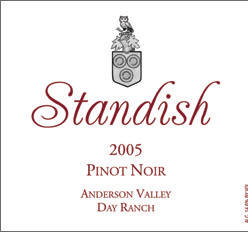 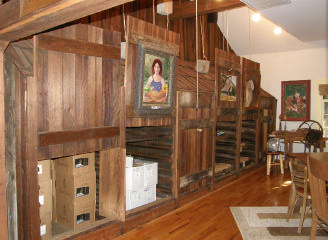 Toulouse Vineyards & Winery Vern and Mazine Boltz are urban refugees from the San Francisco Bay area where Vern was an Oakland Fire Department Captain and home builder, and Maxine was a flight attendant and real estate professional. They purchased 160 acres near Philo in 1997 and planted a 17-acre vineyard to Pinot Noir (clones 2A, 115, 667 and 777). The vineyard was named Toulouse after a huge goose weighing in at up to 35 pounds that thrives in the tranquility of the vineyard. The vineyard has supplied grapes for several other producers such as Pacific Echo, MacPhail, Baxter, J. Jacaman, and Phillips Hill Estates. The Boltzs started their own Toulouse label wines which are sold through the website at www.toulousevineyards.com. Tasting is by appointment, but if the gate is open it is worth checking to see if the Boltzs will receive you. The winery is nothing fancy and rather rustic, but that is not the point. You will be treated very well here by the affable and personable hosts. 8001 Highway 128 in Philo. 707-895-2828.
2006 Toulouse Estate Anderson Valley Pinot Noir $39. · Sporting a mélange of red and black fruits in the aromas and flavors and lively acidity, this one is just fine. Still an infant, but showing nicely at this stage.
 2006 Toulouse Estate Anderson Valley Rosé This is a terrific wine and the best rosé I tasted over the weekend. There is plenty of berry fruit with a touch of orange peel. The brisk acidity leads to a refreshing finish.
Zina Hyde Cunningham The Cunningham family history in Mendocino County dates back to 1865 when Zina Hyde bought property in Ukiah and crafted excellent wines. Bill Cunningham, Zina’s great grandson, encouraged by cousin Steve Ledson, owner of Ledson Winery & Vineyards in Kenwood, started Zina Hyde Cunningham in 2004 in Boonville. Unfortunately the pourer at the Festival was just helping out and didn’t know much about the winery and wines. The quaint Zina Hyde Cunningham Winery and General Store is located in downtown Boonville at 14077 Highway 128 across from the Boonville Hotel. It is open daily from 10-5. 707-895-9462. The website is www.zinawinery.com. Multiple varietals are available from Redwood Valley, Lake County, and the Russian River Valley. The wines are sold through a mailing list and at the tasting room.
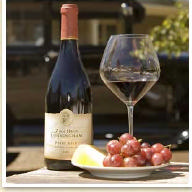 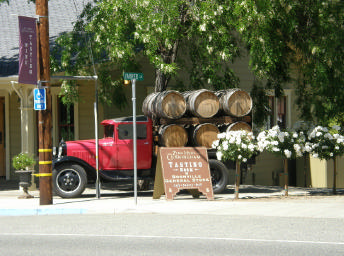
2005 Zina Hyde Cunningham Anderson Valley Pinot Noir 14.2% alc., 370 cases, $40. · Perfectly fine elegant-styled Pinot. Red cherries, strawberries, baking spice, sparkling acidity. Easy to like.
2005 Zina Hyde Cunningham Reserve Anderson Valley Pinot Noir 14.2% alc., 50 cases, $50. · The Reserve has a similar flavor profile but is ramped up a bit in fruit intensity and structure. Nicely spiced red fruits, impeccable balance, and my cup of tea.
Pinot Noirs from Producers Outside the Anderson Valley that Source Grapes from within the Anderson ValleyAnthill Cellars The three amigos who craft these wines are all Williams Selyem cellar refugees. I think a better name would be the three aces as they are crafting nothing but winning Pinot Noirs right now. If you haven’t had Anthill, you haven’t lived. I was shocked to check the website and see 2006 vintage wine still for sale. Strike while you can.
2006 Anthill Farms Anderson Valley Pinot Noir 13.7% alc., $32. · Light crimson in color. Cinnamon spice, cherry, cardamom aromas which are nose-filling. With time in the glass there are more confected grape fruit notes with a touch of alcohol peeking out. Light-weighted and elegant, the wine shows off very appealing cherry and raspberry flavors.. Nothing epiphanic but a good drink and perfect for the table.
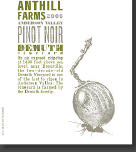 2006 Anthill Farms Demuth Vineyard Anderson Valley Pinot Noir 13.6% alc., $39. · Light crimson robe. Complex nose showing black cherry, truffle, oak and toffee. Charismatic dark stone fruits with an earthy tone. Healthy tannic backbone. Creamy texture and a slightly dry finish. This will only get better with cellaring. I could drink this all night.
Brogan Cellars Margi Weirenga crafts Pinot Noir from Burt Williams’ vineyard, Morning Dew Ranch, in Anderson Valley. Burt is Margi’s father.
2006 Brogan Cellars Morning Dew Ranch Anderson Valley Pinot Noir 14.4% alc., $45. · Shy aromas of cherry syrup, grass and barnyard. Dark red earthy fruits Good acid spine. Not showing particularly well right now but Margi’s wines need some time to develop. Be patient.
Cakebread Cellars Cakebread has a 34 year history of winemaking in the Napa Valley and is best known for Sauvignon Blanc, Chardonnay and Cabernet Sauvignon. The craft Pinot Noir from both the Carneros and Anderson Valley appellations.,
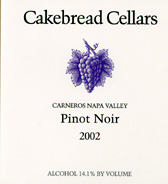 2005 Cakebread Cellars Anderson Valley Pinot Noir 14.6% alc., $49. Sourced from the Cakebread estate vineyard near Boonville. Made from six clones, all vinified separately. Aged 14 months in 46% new French oak. The winemaker is Julianne Lake. · Like many Pinot Noirs I taste from Napa Valley producers, this wine is heavily oaked. There is prodigious fruit which is dark, plumy and earthy. Maybe it was the heat at the Festival, but I just couldn’t get close to this one.
Copain Wine Cellars This winery produces highly touted wines in small quantities crafted by respected winemaker Miles Guthrie in a custom crush facility in Santa Rosa. All of the wines show fairly assertive tannins and are rather exotic. A Hein Vineyard and Dennison Vineyard bottling from the Anderson Valley are also available.
2006 Copain “Tous Ensemble” Anderson Valley Pinot Noir 13.1% alc., $32. · All of the Copain Pinot Noirs show a moderately dark ruby color. The nose leads off with cherry, toast, barnyard and chicken soup aromas. Cranberry, tart cherry, orange peel, and mocha flavors with a citrus edge to the sharp finish. Noticeable drying tannins.
 2006 Copain Cerise Vineyard Anderson Valley Pinot Noir 13.6% alc., $54. · Complex aromatic profile showing black fruits, forest floor, smoke, oak and a whiff of alcohol. Earth-dusted dark fruit which is herbal and wood-toned. Massive fruit lacks finesse. Deep, dark and mysterious, and very primal. Not for Pinot Noir purists. Needs time to shed its bold tannins. Very typical of this vineyard.
2006 Copain Hacienda Secoya Vineyard Anderson Valley Pinot Noir 13.2% alc., $47. · This wine has the most charm and pinotosity of the three 2006 Pinot Noirs tasted. That said, it has a gripy edge with plenty of acidity. The nose is shy and needs coaxing to bring out the savory herbs, strawberry and barnyard scents. The flavors tend toward the red spectrum and are tart. Silky in texture but a bit flat. Noticeable tannins will need time to soften.
Couloir Wines This is a brand new producer releasing its first Pinot Noirs with the 2007 vintage. The founder and winemaker, Jon Grant, is also an assistant winemaker at Turley Wine Cellars. Grant has learned his trade working in numerous Napa Valley cellars including PlumpJack Winery, Corison Winery and Robert Mondavi Winery. Couloir means a steep mountainside gorge and reflects Grant’s love for ski mountaineering. The inaugural wines, both 2007 barrel samples, were offered at the Festival. I tasted both barrel samples and the wines show great promise. I look forward to trying them again when they are bottled. 1-888-COULOIR.
Ferrari-Carano Vineyards and Winery The 2006 Sky High Ranch Anderson Valley Pinot Noir is the inaugural vintage of Ferrari-Carano Vineyard Select Pinot Noir. Yields were only a half-ton per acre from this vineyard which sits among towering redwoods and lush forest high above the fog line on the cool, steep slopes of Mendocino Ridge. Released in May.
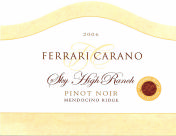 2006 Ferrari-Carano Sky High Ranch Mendocino Ridge Pinot Noir 14.2% alc., $46. · Deep reddish-purple hue. Very appealing aromas of strawberry jam and Bing cherry. Rich, sweet dark berry fruit with a citrus note. Bright acidity on a memorable and long finish. Nicely balanced from start to finish. The tannins are mildly assertive now and will soften with 6-12 months in the cellar. This wine has a lot of charisma.
Fulcrum Wines Winemaker David Rossi crafts Pinot Noir at Crushpad in San Francisco. Reviewed several months ago and re-tasted recently. Still good.
2006 Fulcrum Wines Anderson Valley Pinot Noir 14.2% alc., about 100 cases, $60. 50% Akins Vineyard (Pommard), 25% Hein Vineyard (Pommard), 25% Wentzel Vineyard (Dijon 115, 667, 777). · The aromas of cherry cola and baking spice are very alluring. Nicely presented red cherry and cassis fruit in a lighter and feminine style. Silky on the palate with lively acidity on a lip-smacking finish.
La Crema You can always expect a dependable glass of Pinot from this producer. Good retail distribution.
 2006 La Crema Anderson Valley Pinot Noir 14.5% alc., 2,000 cases, $34. Just released. Clones are Pommard, 115, 667 and 777. · Very heavy bottle, don’t try lifting this with one arm. A black cherry delight from start to finish. Notes of spearmint and smoke add interest to the nose and black raspberry chimes in on the finish. Plush and healthy ripe fruit with velveteen mouth feel. Impeccable balance and thoroughly satisfying.
Littorai Noted winemaker Ted Lemon quietly crafts exquisite Pinot Noirs from purchased grapes of top vineyards in the Anderson Valley, as well as the Russian River Valley and Sonoma Coast. His wines are highly sought after and are only available through a mailing list. The wines described here show the highs and lows of Pinot Noir - it is a difficult grape to corral. I think minx is the proper term. Ted doesn’t believe in frau-frau. His labels are simple and to the point. and there is no BS on the back. The wines do the talking.
2004 Littorai Cerise Vineyard Anderson Valley Pinot Noir 13.7% alc., 95 cases, $60. · Deep, dark ruby robe. Shy nose that needs swirling in the glass, showing dark fruits, toast, and medicine cabinet. A bruising and sinister Pinot that is loaded with rich, dark Pinot fruits and an underlying primal earthiness. Well-crafted and balanced. The soft texture is heavenly. Tasted the next day from a previously opened re-corked bottle and this wine tasted noticeably smoother and more integrated. I would suggest cellaring this wine further or decanting it if you plan to drink it now.
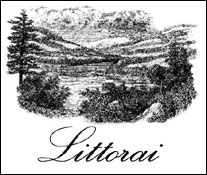 2004 Littorai One Acre Vineyard Anderson Valley Pinot Noir 14.1% alc., 140 cases, $70. · I had a multitude of descriptors for this wine because it kept changing in the glass. Pinot Noir is, after all, a chameleon. At times I noted black cherry, raspberry, plum, sassafras, savory oak, char, violets and some minerality in the aromatic and flavor profile. A full mouthful of fruit but very smooth and light on its feet. Iron fist in a velvet glove comes to mind. Impeccable craftsmanship and a memorable wine. This too drank beautifully the following day indicating there are many good drinking years ahead for this wine.
2005 Littorai Les Larmes Anderson Valley Pinot Noir 14.1% alc., 303 cases, $42. Savoy and Cerise declassifications primarily. · Dark cherry red in color. Strong herbal and mineral bent to the aromas accompanied by reductive matchstick notes. Nice mouthful of black cherry fruit which is clean and pure with a green and citrus note. Something chemical or medicinal is present that I can’t put my finger on. Tasted two separate bottles and both were very similar. I would wait on this wine.
2005 Littorai Roman Vineyard Anderson Valley Pinot Noir 13.5% alc., 36 cases, $65. A 1.87 acre vineyard exclusive to Littorai. · Very dark reddish-purple in color. The nose features deep, dark, super ripe berries, oak shavings, truffle and pine sap. In the mouth there are lovely oak-kissed dark fruits and herbs. Slightly jammy with a suave texture and fine-grained tannins on the finish. Decent but not extraordinary.
2004 Littorai Savoy Vineyard Anderson Valley Pinot Noir 14.2% alc., 360 cases, $55. · saved the best for last. This was one of the best bottles of California Pinot Noir I have had this year and my notes fill up the best part of a page. This is one of those wines that when you pull the cork, sensual musk-like aromas waft up from the bottle immediately. Complex scents explode from the glass including black cherry, chocolate, coffee, smoke, earth, herbs, and barnyard. New aromas dart in and out with each swirl. In the mouth, there is juicy and succulent dark fruits enhanced by anise and tea notes. Bright acidity and gossamer tannins lead to a refreshing grip that draws you to a second glass. This is a tour de force for Anderson Valley. Tasted twice a couple months apart - same result.
Madrigal A small family-owned winery in the Napa Valley (Calistoga) founded in 1993. Madrigal is a producer of several varietals including Cabernet Sauvignon, Petite Sirah and Zinfandel. The winery will soon release a Pinot Noir from Mendocino Ridge.
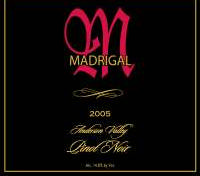 2005 Madrigal Anderson Valley Pinot Noir 15.8% alc., 161 cases, $45. Aged in 22 months in 50% new French oak. Sourced from Toulouse Vineyard. · Tasted briefly at the Festival. Pretty decent wine that hides the alcohol well. Plenty of dark flamboyant Pinot fruits front and center. A wine to sip and contemplate.
Radio-Coteau A boutique producer of Pinot Noir, Chardonnay and Syrah sold primarily through a highly allocated mailing list.
2006 Radio-Coteau Savoy Vineyard Anderson Valley Pinot Noir 14.4% alc., 380 cases, $50. · Reticent black cherry and oak spice scents. Earthy with sappy dark fruits and some drying tannins on the finish. Tight and not ready for prime time.
Saintsbury Four single vineyard Pinot Noirs from Saintsbury come from Carneros. Cerise Vineyard is the lone Anderson Valley source.
 2006 Saintsbury Cerise Vineyard Anderson Valley Pinot Noir 14.0% alc., 225 cases, $45. · Subdued aromas of cherries, berries, herbs and dark chocolate with a hint of alcohol. Picks up steam in the glass. Rich and muscular black cherry core of fruit with assertive tannins that need time to soften. Very comforting soft and creamy texture and a very long finish. A lot of potential here, but patience is needed.
Whitcraft Winery Chris Whitcraft has been making Pinot Noir for what seems like an eternity. Based in Santa Barbara County, he is a legend in his own time. His friendship with Burt Williams has allowed him to add a Morning Dew Ranch bottling to his Bien Nacido Pinot Noir lineup. His wines are not for the faint of heart, and are a bit off the beaten track.
2005 Whitcraft Winery Morning Dew Ranch Anderson Valley Pinot Noir 12.4% alc., $50. · Unusual aromatics but some recognizable ripe crushed berries, musk, and floral elements. Sappy dark fruits including wild blackberries surface with a soapy, floral, and sour overtone. Way too much tannin and far too tart on the finish. A strange wine that defies description. Probably a bad bottle.
Woodenhead Vintners A Williams Selyem spin off located in Forestville, Sonoma County that has made some wonderful Pinot Noirs. Nikolai Stez is at the helm and developed a friendship with Burt Williams while working at Williams Selyem for several years. The two wines below have not been released.
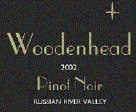 2006 Woodenhead Vintners Morning Dew Ranch Anderson Valley Pinot Pinot 13.5% alc.. · A terrific Pinot brimming with spiced red fruits that are caressing in the mouth. Excellent balance and length with a long, powerfully aromatic finish. Clearly one of my standouts at the Festival.
2006 Woodenhead Vintners Wiley Vineyard Anderson Valley Pinot Noir 14.7% alc., 358 cases, $60. · This is as different from the Morning Dew bottling as night and day. A big, big wine, dark and brooding, loaded with tannin. Impenetrable now. Wiley Pinots from past vintages have been outstanding indicating patience is required with this one.
Additional Information and MapsFor more information and maps of the Anderson Valley, consult the following websites: Anderson Valley Winegrowers Association - www.avwines.com Anderson Valley Chamber of Commerce - www.andersonvalleychamber.com Mendocino Winegrape and Wine Commission - www.mendowine.com Anderson Valley Home Page - www.andersonvalley.org
Places to Recommend on the Pinot TrailIf you want lodging in Anderson Valley: Apple Farm is a 32-acre organic farm and apple orchard with a cooking school and three cottages run by Dan and Sally Schmitt, the original owners of the French Laundry (707-895- 2465). The Boonville Hotel is operated by the Schmitt’s son, Johnny, who doubles as the chef in the hotel’s excellent restaurant open on weekends for dinner (707-895-2210). Holly Hill Farm B&B is a nice guesthouse (707-895-2269). Indian Creek Inn is a modern inn next to Goldeneye Winery in Philo (currently for sale - 707- 895-3261). Anderson Valley Inn is an inexpensive 7 room inn in Philo (707-895-3325). If you want to stay on the Mendocino Coast: Albion River Inn has deluxe accommodations that overlook the Pacific Ocean with a first-class restaurant (800-479-7944). The Rendezvous Inn & Restaurant in Fort Bragg is housed in a lovingly restored old home with a gourmet restaurant that offers the best dining on the Mendocino Coast (707-964-8142). Elk Cove Inn is perched on a bluff overlooking a wind-swept ocean cove and is the quirkiest lodging you will ever experience (800-275-2967). If you are hungry in Anderson Valley: Moya Taco Truck in downtown Boonville. Mosswood Market Café & Bakery has great sandwiches and wraps in Boonville. Libby’s is the local’s favorite for Mexican food. Redwood Drive-In Café is a typical small-town café. Boonville Hotel described above. Many of the wineries have excellent picnic spots - pick up supplies at the markets in Philo or Boonville or the Mosswood Market Café & Bakery. If you are hungry on the Mendocino Coast in addition to the above: Café Beaujolais, Ledford House, Mac- Callum House Restaurant, Stevenswood Restaurant, The Ravens at the Stanford Inn By the Sea. |
